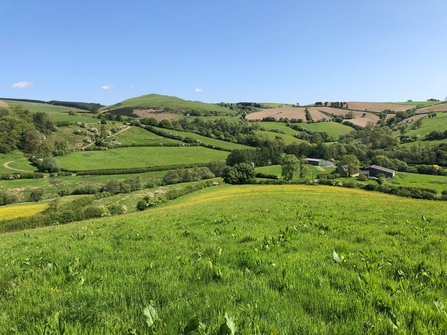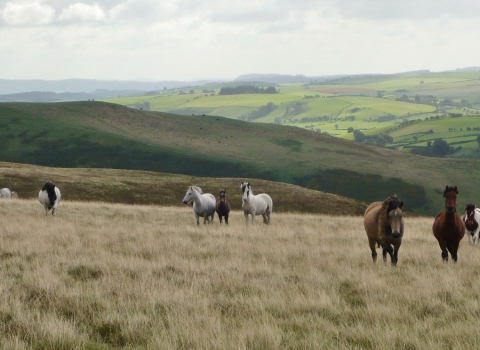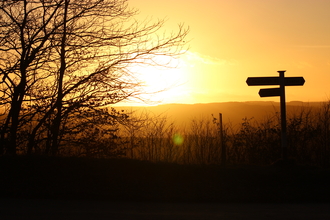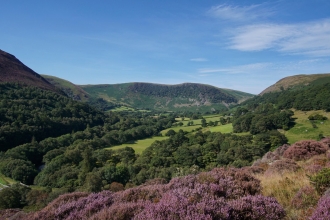Aside from the valleys where the River Wye and its tributaries flow, Radnorshire is comprised mostly of upland, an area classed as anywhere over 200m above sea level in altitude. Uplands are not in themselves specific habitats; heathland, peatbog, broadleaf woodland, and acid grassland habitats can be found throughout the county at these elevations, and as you move back down towards the lowlands; fringe transitional habitats such as scrub and ffridd can thrive.
The uplands support a huge variety of some of our most precious and declining wildlife. Marsh violets and sphagnum mosses can thrive in peatbogs; bell heather, bracken and bilberry bushes make up heathland and ffridd, providing habitat for stonechat, whinchat and yellowhammer. You can find areas of broadleaf woodland consisting of oak, beech, and ash, and carpeted with bluebells; filled with the songs of pied flycatchers, redstarts, and the occasional call of a cuckoo. While all possible to find in Radnorshire, the majority of the uplands are not like this. The songs of skylark and the burbling calls of curlew are becoming less and less frequent.
The Welsh uplands are a place of uncertainty. The majority of land-use is agricultural, and the majority of that is pasture used for cattle and sheep grazing. With questions about the future of farming in Wales post-Brexit, Radnorshire Wildlife Trust is working hard to help settle some of this uncertainty.
What are we doing to help?
Pentwyn Farm

(c) Megan Abram
In 2021 Radnorshire Wildlife Trust was loaned £1.5 million by four generous individuals to buy Pentwyn Farm, a 164-acre upland farm in the Welsh Marches, as of January 2024 we have paid back the land. Pentwyn has historically been managed as a livestock farm, and Radnorshire Wildlife Trust is leading the way in the county by displaying how an upland farm can be transformed and managed for nature. We want Pentwyn to become wilder by making space for nature and allowing natural processes to take lead, but we also want it to be a farm: A new model farm for the future, with high welfare, low input meat produced from the livestock that help to accelerate natural regeneration; and vegetables, fruit and nuts produced from the market gardening business. In 2023 we started the Wilder Pentwyn Project, focused on accelerating the recovery of the land, and engaging the local community, ensuring they have a greater sense of stewardship of our landscapes. To help settle some of the uncertainty surrounding farming in the area, we run regular Farm Clusters, equipping landowners with helpful, actionable advice about different topics, and providing a platform for discussion. We host tours of the site, showing people the benefits of letting natural processes develop. If you would like to get involved, please contact Chloe Jackson, Wilder Pentwyn Project Officer, at chloe@rwtwales.org
Upland Land Management
(c) Silvia Cojocaru
For centuries Gilfach was a working hill farm; today it's a spectacular 162-acre nature reserve tucked away in the Marteg Valley in the heart of rural Mid Wales. Bought in 1988, Gilfach is a rare example of a farm that never modernized. While the land had suffered a little from overgrazing, we were already working from a high natural baseline. The wildlife has thrived here due to the Trust’s management of the site, focusing on mimicking natural processes using large herbivores with minimum human intervention. Gilfach is grazed year-round by traditional Welsh cattle, which break up the grass and soil before being moved to a new patch using GPS collars. The reserve has a wide variety of habitats for its size. Heathland, oak woodland, species-rich grassland and rhos can all be found in close proximity; a patchwork that supports a many of our declining species. Gilfach is an example of what the future could look like for a hill farm; and almost 40 years on from the purchase, Radnorshire Wildlife Trust is still showing people how that change can take place.
Matt Roberts
Just north of Pentwyn Farm, is Cnwch Bank, an upland reserve owned by Radnorshire Wildlife Trust and part of Beacon Hill, a large area of wild upland. Dense patches of heather and bilberry survive on the high slopes, with wet flushes and pools dotted throughout. A favourite place of walkers and wildlife lovers, Radnorshire Wildlife Trust has been showcasing how upland areas can become havens for wildlife, Cnwch Bank now supports merlin, peregrine falcon, stonechat and other birds that thrive in wild uplands. Right at the rooftop of Radnorshire, Mynydd Ffoesidoes has some of the finest heathland in the county. Hen harriers soar over the marsh heathland, which is broken up by boggy pools, with deep peat soils.
Wilder Marches

Wilder Marches is a collaborative project run in partnership with Radnorshire, Montgomeryshire, Herefordshire and Shropshire Wildlife Trusts. Focused on restoring an estimated 100,000ha along the Welsh Marches by creating, expanding and restoring habitat, and supporting regenerative farming in tandem with land managers. Our vision is a thriving natural world, where wildlife and natural habitats play a valued role in addressing the climate and ecological emergencies, and everyone is inspired to get involved in nature's recovery. For more information, please contact Jenny Jackson-Tate, Wilder Marches Programme Manager, at jennyjt@wildermarches.org.uk




